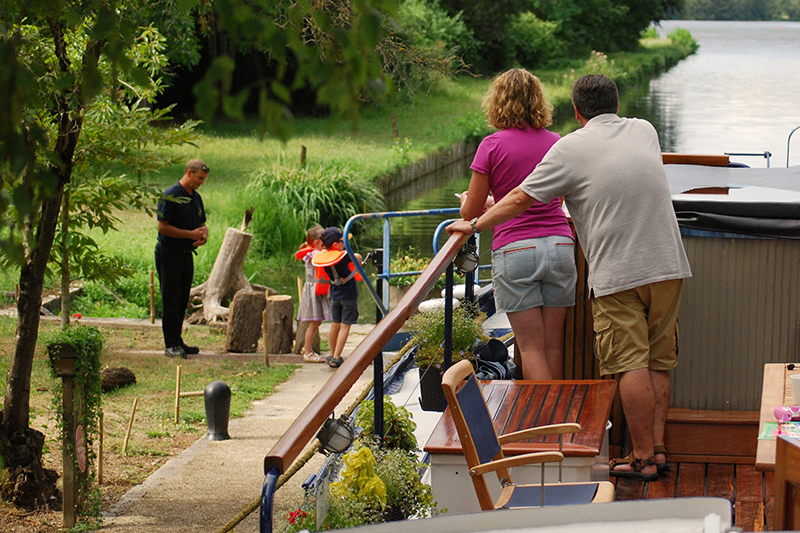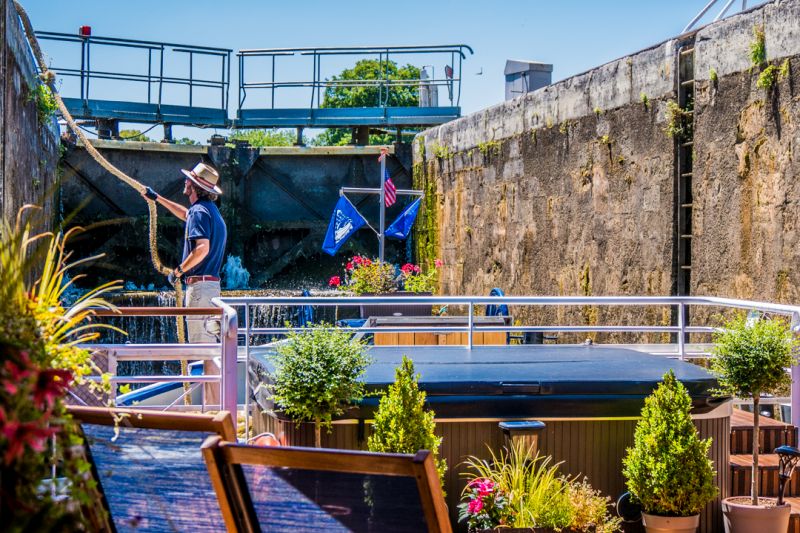How do canal locks work? Since antiquity, rivers have been used to transport goods, but gaps in the network forced overland transport for part of the journey. Seeing as trading routes and crossroads were of economic importance for the region, systems of navigable waterways, including canals, began to be created.
Locks were built to enable the canals to cross the hills which separated the various river basins. The frequency of the locks depended on the gradient to be climbed. Read on for more information on how canal locks work…
How do Canal Locks Work?
For a boat to go up through a canal lock, the following sequence occurs:
- The bottom sluices are opened to allow the lock to drain
- The lower gates can then be opened
- With the gates opened, the boat can enter the lock
- The lower gates and bottom sluice are closed
- The top sluices are then opened so that the water level rises in the lock, floating the boat up to the next level
- The top gates can now be opened
- The boat is then free to exit the lock on the new level. To descend the canal lock, the reverse happens. The lock is filled (if it is not already), the boat enters the lock which then drains, allowing the boat to exit on the lower level.
What are the Different Types of Canal Locks?
Flash Locks
Early navigable inland waterways were simply natural rivers. Boats could only travel as far as the river had adequate depth and could gain elevation only by travelling upstream, climbing the slight gradient of a flowing river, albeit with difficulty. The earliest canal locks, known as flash locks, saw their origins with the Romans in mainland Europe and with Viking raiders in Britain and Scandinavia. A weir or barrage would be built across the river with an opening in the middle, usually kept shut with a gate.
When a boat wanted to pass downstream, the flash lock would be opened, and the boat would be carried through the gap and over the weir with the sudden rush of water. If a boat wanted to travel upstream, it would generally be carried over the step by a group of men, team of horses or by a winch or capstan. This was unreliable, however, and it would sometimes take days or weeks before there was enough flow in the river to allow the boat to successfully navigate the canal lock. Despite this, flash locks were in use on the Avon in Warwickshire, England, until the 1950s! Read on for more information on how do canal locks work.
Lock Gates
Originally canal lock gates were built as vertically opening structures, not dissimilar to a portcullis on a castle. Because the pressure of the water was up against a single flat surface, it would often find weaknesses in the door and leak through. It was also very difficult to raise such a heavy gate.
The Miter Lock
It was thanks to Leonardo da Vinci’s invention of the Miter lock in 1497, however, that locks are used as widely as they are today and have since become the standard design of lock building.
The Miter lock consists of two gates which swing open on a hinge in unison. When closed they press up against each other at 45°, meaning the pressure of the water only closes them tighter. When there is an equal level of water on either side, the open with ease.
Sluices
Sluices are opened and closed in the doors which allow in water to either fill or empty the canal lock. As water is replenished from a reservoir higher in the network, a channel carries water past the lock into the lower pound to prevent water from overflowing the banks of the canal while the lock gates are shut.
The Pound Lock
Its successor was the pound lock – a chamber with gates at both ends which was first used by the Chinese in the 10th century and later by the Dutch and Belgians in the 14th century. The pound lock allows boats to move between levels easily, without affecting the general levels of the river, and without great delays. The invention of this type of lock allowed the construction of canals, i.e., waterways not requiring a natural flow. With this arrangement, when a boat wants to pass from one level to another, only the relatively small volume of the chamber needs to be filled, rather than a whole reach of the waterway.
The term ‘pound’ refers to the stretch of water between two canal locks.
Canal Lock Placements
Early canals placed locks wherever there was a contour change in the landscape so that the canal channel could be built as easily as possible. As a result, the spacing between locks varied greatly. From the construction of the Canal de Briare, the oldest in France, canals were built with a summit – meaning that the navigation would use locks to climb to the summit and then descend to the joining waterway.
As construction technology developed, embankments and cuttings, aqueducts and tunnels were introduced. The first aqueduct built within a canal was that of La Repudre on the Canal du Midi in the year 1671. From here on, slight changes in the topography of the land could be accommodated without the need for locks.
With better construction technology to maintain a level canal, it became possible to decide where to build canal locks. It was usually more cost effective for construction and for operation to put a number of locks together in one place as this reduced the time taken for boats to pass through and allowed for easier supervision.
Lock Flights
Flights (a series of locks) are used when a canal must make a change in level greater than could be achieved by a single chamber. Up to 30 locks can be used in a series, such as those on Caen Hill on the Kennet & Avon Canal in England, each using the water discarded by the lock above, so that the whole series uses the same quantity of water as a single lock. Normally, the pounds between each lock in the flight are big enough to allow boats to pass each other, so that it is possible to alternate in each lock with barges climbing and descending the series at the same time.
Staircase Locks
Where locks have to be placed very close together, a more common arrangement is a staircase, which is cheaper to build. A staircase lock looks very similar to a series of locks (lock flights), with the difference that there is only one set of gates between each chamber, so that the top gates of one lock are also the bottom gates of the canal lock above. The most famous of staircase locks is that of the “seven locks of Béziers”, which is part of our Anjodi cruise on the Canal du Midi.
Can I Operate a Canal Lock?
Locks can be operated in one of three ways; some locks are operated by a lock-keeper, some can be operated by yourself and others are automatic in which a simple push of a button by the deckhand on shore starts a pre-set locking procedure. Usually lock-keepers are very happy to show you how the canal locks work.
Are Canal Locks A Thing of the Past?
Many alternatives to locks have been tried out by canal engineers, eager to reduce the loss of water during lock operation, (about 50,000 gallons for a narrow lock!) and to save the costs of lock construction.
Vertical elevators, wet or dry, lift vessels vertically.
Dry lifts are little more than cranes to lift small vessels from one canal to another.
Wet elevators transport vessels while still afloat, and make use of Archimedes’ Principle, i.e., that a watertight chamber or caisson full of water weighs exactly the same as a caisson with a boat in it as the boat displaces a volume of water equivalent to its weight. This allows the boat lift to be finely counterbalanced, so that the only mechanical effort that needs to be put in is to overcome friction.
One such boat elevator which is possible to see in action is the Saint-Louis-Arzviller inclined plane, which forms part of the hotel barge Panache’s route in Alsace. Built in 1969, it was used to bypass a flight of 17 locks over a 4km canal, which would take a full day to climb or descend. Travel time dropped dramatically to four minutes. The only other structure of this type was the Foxton Inclined Plane, dating from 1900, in Leicestershire, England.
Ready to Navigate Europe's Canal Locks?
Hopefully you now understand how canal locks works. For help in discovering Europe’s finest waterways, talk to a member of our Sales Team who will assist in finding your perfect barge cruise, and perhaps navigate them yourself!
 English
English
 Spanish
Spanish French
French German
German Norwegian
Norwegian Portuguese
Portuguese Swedish
Swedish Italian
Italian Russian
Russian Simplified Chinese
Simplified Chinese Japanese
Japanese


